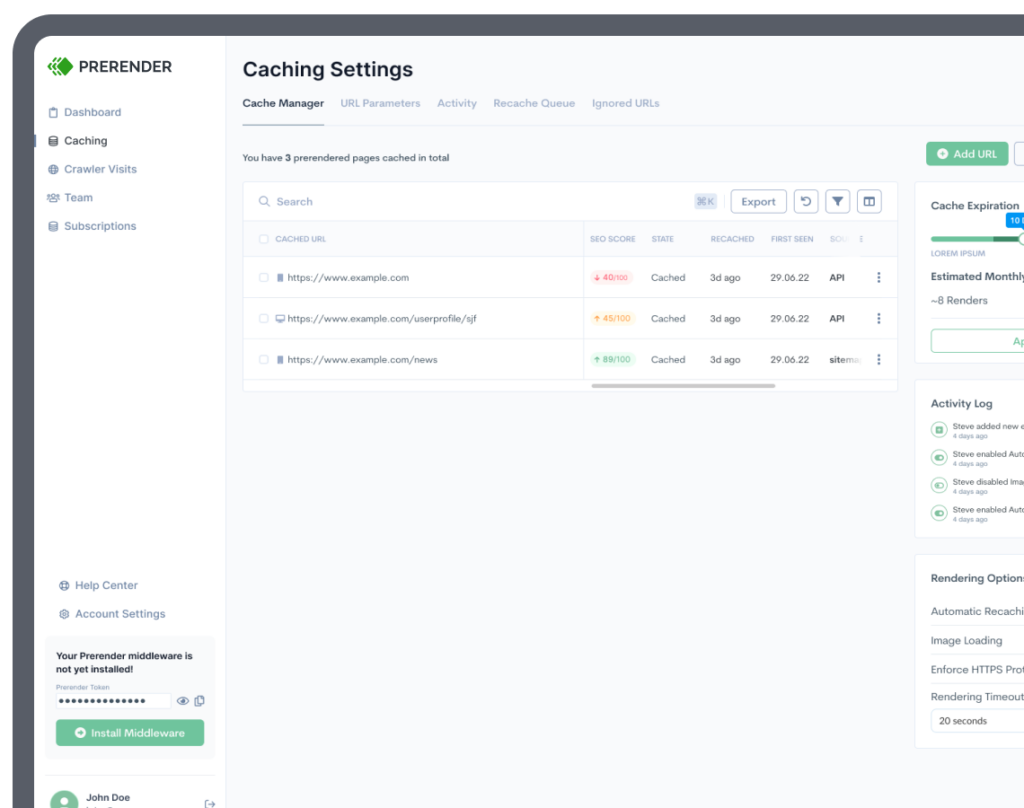As an SEO professional, you may have spent a lot of time optimizing new content but still fail to meet your ranking potential. It can be because you ignore one invisible threat: index bloating.
Index bloating presents challenges for both search engines and website owners. It complicates search engine algorithms’ task of identifying valuable content, leading to fewer site crawls. Additionally, it buries high-quality content under less valuable pages, lowering the visibility and overall rank potential of your site.
Fortunately, solving index bloating is easy. In this article, we’ll look at what index bloating is, how it affects crawl budgets, and explore practical ways to solve this issue to improve your website’s online visibility.
What is Index Bloating?
Index bloating occurs when your website gets overwhelmed with low-quality pages and forces Google indexing crawlers to spend valuable time combing through these instead of focusing on more important pages.
This bloating wastes precious crawl budget (the limited resources search engines allocate to crawl a website), making indexing less efficient. Consequently, it can negatively impact your technical SEO scores, rankings, and user experience.
Related: Follow our crawl budget optimization guide to speed up the Google indexing process.
Simply put, index bloating happens when the quantity of pages in your indexing list massively outpaces the quality and usefulness of those pages.
Index bloating is especially common on e-commerce websites that house hundreds of thousands of products, categories, and customer reviews. Generally, your site’s index can become bloated due to various reasons:
- Thin content: Pages with short or low-quality content provide low value to users and may be regarded as poor quality by search engines. However, they can still be indexed, especially if they are automatically generated or are extras from site updates.
- Duplicate or near-duplicate content: When numerous pages on your website have identical or extremely similar information published across multiple URLs, search engines may index them all, resulting in duplicate content issues.
- Faceted Navigation and parameters: E-commerce sites and other platforms with faceted navigation often generate numerous URL variations based on filters, sorting options, etc., resulting in many near-duplicate pages that are indexed unnecessarily.
- Media pages: Excessive image galleries and video collections with poor metadata.
- Tag Pages and archives: While these pages serve organizational purposes, they may not offer unique value and can contribute to index bloating if not properly managed.
- Missing robot.txt files: Robots.txt file is a text file located at the root of a website’s domain that tells web crawlers which pages should and should not be indexed. When it is missing, search engine bots may crawl and index sites that should not be included, resulting in index bloating.
Related: Learn 6 best practices for optimizing robot.txt files to enhance SEO performance.
How Index Bloating Affects SEO Performance
With over 1.13 billion websites online, search engines have a limited “crawl budget” for each website, meaning they can only visit and process a certain number of pages within a timeframe.
With index bloat, your site’s important pages may be crawled but not indexed, and once your budget is depleted, the indexing process will stop. Consequently, this postpones your content to show up on SERPs, potentially hurting your website rankings, and lowering the conversion rates.
Besides the crawl budget limitations, Google is known to only index a certain number of pages from your website. This leaves valuable content unexplored and potentially underexposed. A high-quality page that typically gets 7,000 visits may only get 2,500 if Google indexes the undesirable pages competing for the same traffic.
Index bloating can also decrease click-through rates (CTR) and poor user experience (UX). When searchers are presented with pages from a bloated index, they have to sift through more low-quality results to find what they want, leading to more bounces and fewer clicks on your pages. Over time, this drives down your CTR, causing Google to trust and give you lower rankings.
Here’s an overview of how index bloating impacts SEO health:
- Wasting valuable crawl budget on pages that bring nothing to your business growth
- Hurting rankings, lowering traffic, and ultimately decreasing conversion rates
- Decreasing CTR and generating poor UX
In short, index bloating dramatically slows down your SEO progress while subtly diluting the power of your best content. It is like trying to get out of quicksand; it drags you down at every step.
How to Identify Index Bloating
To know if your website has index bloating, you have to assess the total number of indexed pages on your website. You can do this by going to Google Search Console and checking the Index Coverage Report.
The report provides key index coverage insights by displaying:
- The total number of your web pages Google has included in its search results database
- The current indexing status of those pages, and
- Crawl activity detailing whether Google’s bots have visited each URL to assess its content.
Compare the number of “Valid” pages to the number you want indexed and submitted in your sitemap. If you find a significant difference, you’re likely to have index bloating. Additionally, monitor overall crawl activity and identify unexpected spikes that might suggest excessive crawling of low-quality pages.
6 Proven SEO Methods to Fix Index Bloating
You now understand how to identify pages that cause index bloat. The next and most important step is to solve it. Here are 6 ways to effectively do it.
1. Conduct An Index Audit
Dig into Search Console and Google Analytics to classify the value of indexed pages. Sort into:
- Cornerstone content to keep
- Middling fluff to beef up or consolidate
- Useless zombie pages to axe or redirect
Segmenting pages in this manner highlights consolidation and pruning opportunities, allowing legacy content equity and ongoing link flow to get efficiently transferred to areas of your site best serving user needs. This process will also reveal site architecture gaps that need new content allocation.
2. Remove Internal Links
Examine the internal linking configuration of your website and pinpoint pages that are of low quality, redundant, or no longer necessary. Remove internal links to these sites to prevent search engine crawlers from accessing and indexing them. Prioritize directing internal link equity to important sites to improve their indexing and ranking potential.
3. Set up the Proper HTTP Status Code
To enhance site authority and reduce 404 errors, remove thin-content by redirecting them with a 301 redirect to relevant content on the site. This preserves backlink value and minimizes errors. Use an HTTP status code of “410” for content that is no longer relevant for quick removal from search engine indexes.
4. Set up Proper Canonical Tags
Search engines like Google prioritize pages with canonical tags in the header section (<link rel=”canonical” href=”<URL of the original page>) for indexing. This not only prevents duplicate pages from being indexed but also consolidates link equity and redirects it to the main page.
5. Update the robots.txt File to “Disallow”
The robots.txt file instructs search engines on which pages to crawl or avoid. By selectively using the “disallow” tag in this file, you can stop Google from crawling certain pages. This blocks unwanted pages from entering the index waiting list in the first place, allows the removal of pages as a group, and helps free up the crawl budget.
However, blocking pages via robots.txt doesn’t always remove them from Google’s index, especially if they’re already indexed or linked internally. To completely disable indexing, you have to use the “noindex” tag in the site’s header.
6. Use the URL Removals Tool in Google Search Console
If you’re certain that certain pages were incorrectly indexed and should not appear in search results, use Google Search Console’s URL removal tool (or similar tools for other search engines) to request their removal from the index.
Minimizing Index Bloating and Crawl Budget Spent With Prerender
Due to limited crawl budgets for websites, it’s crucial to guide crawlers towards high-value pages first. However, many modern sites use complex JavaScript rendering to show dynamic content, causing bots to index placeholder pages that lack useful content, leading to index bloating.
To optimize crawl budgets and improve JS site indexing for Google, you need to incorporate JavaScript SEO practices. Although Google has improved JS indexing, delays still exist and can lead to index bloating if pages are crawled prematurely.
That’s where Prerender comes in.
Prerender is an efficient solution to solve JavaScript SEO and index bloating issues. It generates static HTML versions of your dynamic content and serves them to search engines. This way, you eliminate the need for Google indexing JavaScript crawlers to wait for pages to load and the complexities of rendering JavaScript.
As a result, your pages get indexed faster and perfectly all the time, boosting your SEO performance and visibility. If you’d like that for your website, you can start with Prerender now to enjoy all its benefits.
Prevent Index Bloating For Smooth Google Indexing Process
At the end of the day, index bloating subtly sabotages sites through a thousand small cuts that drag down performance. What may seem like SEO victories actually undermine your crawling capacity and ability to outrank competitors.
If your website has been around for a while, it’s best to do a full website audit and maintenance check yearly. Go through all your pages with a fine-tooth comb – are they still relevant, helpful, and up-to-date? Or are some of them outdated, thin, or duplicative?
To prevent index bloating and other JavaScript SEO problems obstructing your content from ranking high, adopt Prerender. We have helped 2.7 billion web pages to be crawled 20x faster.



